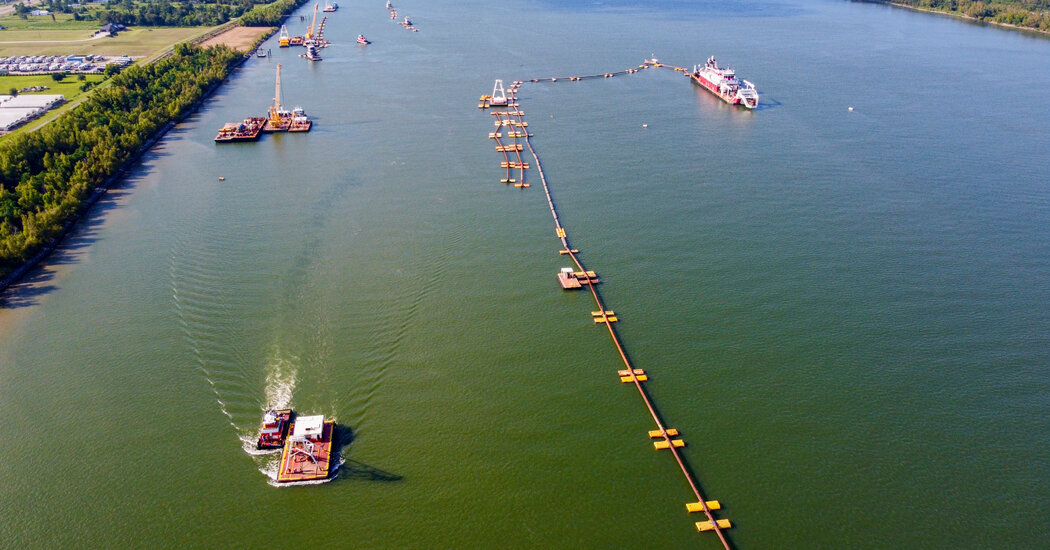
 News
News 
Drought-like conditions in the Midwest over the summer have created a growing water problem in the New Orleans area this fall.
Water levels of the Mississippi River have dropped low enough to make the river less resistant to a mass of saltwater flowing north from the Gulf of Mexico. This circumstance, known as saltwater intrusion, is endangering the drinking water systems in and around the city, as well as smaller municipalities to the south.
Officials in Louisiana and with the U.S. Army Corps of Engineers say that a “saltwater wedge” could reach water treatment plants near New Orleans in October and are working to slow the influx while also bringing in more fresh water to the region. Many water treatment facilities cannot handle water with high salinity levels, which corrode pipes and cause metals in the pipes to leach into the water.
“This is a serious situation,” Gov. John Bel Edwards said at a news conference on Friday. He said he was requesting a federal emergency declaration, and Mayor LaToya Cantrell of New Orleans signed an emergency declaration for the city on Friday. But Mr. Edwards urged people to stay calm, and state officials advised against overstocking on water.
In July, the Army Corps of Engineers built an underwater sill, or levee, in the Mississippi aimed at impeding the flow of the saltwater, which moves beneath fresh water, closer to the bottom of the river. Officials said on Friday that within days, they will begin work to make the sill 25 feet higher.
But even that will only delay the progression of the saltwater wedge by 10 to 15 days, they said. Unless there is significant rainfall soon — and forecasts say there is not — the sill will eventually be topped, Col. Cullen Jones of the Army Corps said.
The Corps of Engineers is also getting barges to transport water that can be combined with water at the treatment facilities for safe drinking. Colonel Jones said about 15 million gallons will be delivered in the coming days, but the demand at treatment facilities could ultimately rise to at least 36 million gallons per day. Colonel Jones said that the Army Corps was working to get access to more barges but that he was confident that figure could be met.
Many coastal communities, like parts of the Jersey Shore, Long Island and the Outer Banks of North Carolina, are no stranger to saltwater intrusion, which also occurs when storm surges or high tides top areas that are low in elevation. As sea levels rise along the coasts, the threat of saltwater intrusion does, too. Other countries like Bangladesh are grappling with that reality.
Saltwater intrusion also affected Louisiana in 1988, when the levels of the Mississippi, whose mouth is below sea level, reached historic lows. An earlier than expected increase in water flow helped ease the problem then. But this is the second straight year in which water levels in the river have dropped drastically because of extreme heat and drought linked to climate change.
Chris Anderson, a professor of wetland and coastal ecology at Auburn University, said it was normal for there to be upriver movement of saltwater. But the more intense the drought, the higher up the river the saltwater could go.
Though the issue has gained heightened attention in recent days as the saltwater heads toward more populous areas, officials have been aware of the problem since the early summer. The lower portion of Plaquemines Parish, on the southern edge of the state, has had drinking advisories in place since June and has been working with the state to provide bottled drinking water for residents.
But a spokesman with the state’s Office of Homeland Security and Emergency Preparedness said there was no reason for the public to stockpile bottled water.
Ms. Cantrell, the mayor of New Orleans, also sought to ease people’s fears. “The most important thing for residents at this time is to stay informed and remain calm,” she said in a statement.
Mr. Edwards on Friday took a similar stance, though he said that the challenge was daunting and that the problem could last longer than it did in 1988. “We don’t experience this all that often, at least not up this far of the river,” he said.
24World Media does not take any responsibility of the information you see on this page. The content this page contains is from independent third-party content provider. If you have any concerns regarding the content, please free to write us here: contact@24worldmedia.com